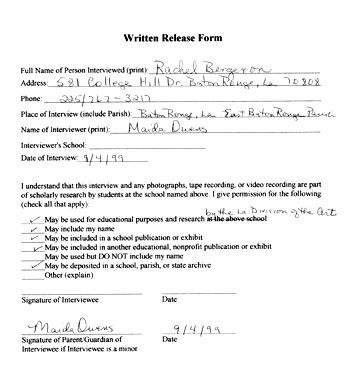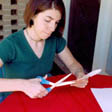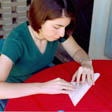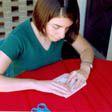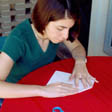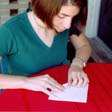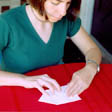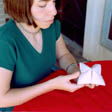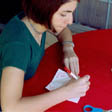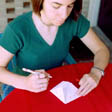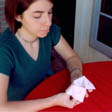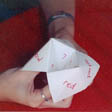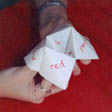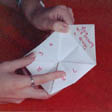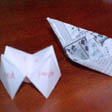Sample Fieldnotes: Teen Memories of Grade School Traditions
By Maida Owens, Louisiana Folklife Program
These fieldnotes and interview transcript are provided as an example of how one folklorist took a research idea and developed it. These notes show how serendipitous fieldwork can be. It is difficult to predict exactly how a field project will develop, where ideas will come from, who will cooperate, and who won't.
Fieldnotes are highly personal and vary among researchers. This particular format is similar to journaling and uses two-column, steno pad format.
WEDNESDAY, JULY 7, 1999
Paddy Bowman, the lead writer of Louisiana Voices, and I brainstormed on folklife research subjects that relate to students' everyday experience. She mentioned that most elementary school children make things of folded paper. I said my 17-year-old daughter, Rachel, used to make something out of paper to tell fortunes. I suggested that I interview Rachel about her memories of doing this. It would be an example of documenting a teenager remembering her own folk traditions as an elementary school child. Paddy said that if I documented my research process, this would do two things: provide documentation of a student tradition and an example of the fieldwork process and fieldnotes.
THURSDAY, JULY 8, 1999
I asked Rachel if she remembered folding paper to make something that she told fortunes with. At first she wasn't sure what I meant, but with a bit more description she said, "Of course." She said that she hadn't thought about that in a long time. I asked if she would agree to be interviewed. Since she had grown up with me doing such things, she was familiar with the idea. But when I said that I wanted to put the interview online, she wasn't so sure, especially since I also wanted to include photographs of her folding the paper. I told her to think about it, and that she didn't have to do it.
NOTES
I don't really remember doing much with folding paper. I do remember spending most of 8th grade French class making spitballs and sticking them down a little hole in my desk. I don't think of spit balls in the same category as folding paper, though. I wonder why I immediately thought of spitballs when I thought of paper folding. I wonder if my kids make the same connection?
FRIDAY, JULY 23, 1999
I asked Rachel again about being interviewed about paper folding. She seemed a bit shy about it, but agreed to be interviewed. She immediately folded a fortuneteller, but I said that I didn't have the tape recorder at home to do the formal interview, so we couldn't do it right now. I told her the type of things that I would ask her.
At what age did she do this type of paperfolding?
Why did she do it? In what types of situations did she do it?
Why did she stop doing it?
Suddenly a paper airplane whizzed by. Rachel's 19-year-old brother had overheard our conversation, made a paper airplane, and shot it at me. I asked him if he would agree to be interviewed, and he said, "No way. Absolutely not." I asked why, and he said that he didn't want to be on the Internet. So I asked if I could include a photo of his airplane in the project, and he said that would not be a problem.
SATURDAY, AUGUST 14, 1999
I wanted to experiment with photographing the folded paper before the actual interview. Also, I had recently gotten a digital camera and needed to get familiar with it. I was also concerned about photographing something white. Since the white paper was the subject of the photographs, it would need to be carefully planned so that the photographs would be usable. Without a carefully planned background, the paper would not show up.
I was right. The white paper was going to be a problem with or without a flash. On my white kitchen counter, the white paper did not show up. I tried it on my wooden kitchen table and that didn't help much because the room was quite dark. The flash on the digital camera was not sufficient for this photo shoot. The flash simply washed out the paper. The great thing about the digital camera was that I could find out immediately whether a shot worked.
NOTES
Remember to get from work:
1. Digital camera
2. Plenty of computer disks. (The disks fill up fast, especially when the setting is on fine).
3. Tape recorder
4. Audio cassettes
5. Batteries for recorder and microphone
6. Release form for Rachel to sign .
SATURDAY, AUGUST 21, 1999
I asked a group of Rachel's friends about folding paper. At first, they thought I was nuts to be asking about this. Why would anyone care about such a thing? Rachel explained that I was a folklorist and documented lots of unusual things like that. After explaining the project, they thought that it was cool. I asked them if they made the fortunetelling thing, and some said they did and others said they didn't. One said that some girls really got into doing that and others didn't. No one seemed to have a name for it, but they all knew what I was talking about.
I asked if they made anything else with paper. One said that some kids really got into origami. I asked how they learned it, and she said that some teachers taught it in class or kids took a class in it. Since this evidently wasn't a folk tradition among this group, I didn't ask more questions.
SUNDAY, AUGUST 22, 1999
I asked my son about paper folding. Did he only make airplanes? He said that was the primary thing. He didn't do a lot of it--mainly in class to annoy teachers. Then he smiled and said, "Spit balls!" I asked if he considered spit balls related to paper folding, and he said, "Of course. They both annoy teachers." He then told me about making giant spitballs, so big that he could hardly get them out of his mouth.
NOTES
Could spitballs really be considered part of the paperfolding tradition? I made the association earlier, but I don't know about this one. I have the feeling that I have been duped. Or is he serious?
Maybe there is a whole genre of traditions that could be called "teacher annoyances," slow motion race to the pencil sharpener, passing notes, spitballs, paper airplanes, putting pencils up your nose.
THURSDAY, AUGUST 26, 1999
Rachel and I decided to set up the interview for Saturday, September 4, since both of us were free in the afternoon. Also, the weather was expected to be good, so we could do the photographs outside. Rachel's grandmother overheard us and asked what we were doing. After we explained, she said that when she was little, she always made a paper hat. She asked for a piece of newspaper - it had to be made out of newspaper, not any other type of paper - and quickly folded a hat. I asked if we could photograph her making a hat, and she said, "Certainly," but she would not be in town on the 4th. She said that it looks a lot like a boat also. They called it both.
NOTES
Remember to discuss with her the next time she is in town. I wonder if she would be willing to be interviewed or have photographs put on the Internet. I wonder if she used the funny papers to give it color.
SATURDAY, SEPTEMBER 4, 1999
This would be a good day for doing the interview, but not the photographs because it was raining. So we decided to go ahead with the interview and wait on the photographs. We were alone in the house, and we didn't expect anyone.
I set up the tape recorder and tested the sound level. I listened for any sounds. No appliances were running (except the refrigerator, which was quiet). The TV and radio were off. No fans were running. The air conditioner didn't seem to be a problem.
I told Rachel that I was ready. So we sat down, but as we did I realized that our kitchen chairs squeaked loudly, so we switched chairs. I wanted the clearest recording possible even if it wouldn't be used online. Transcribing over background noises is very annoying. I knew that it was worth the extra effort just to make transcribing easier.
NOTES
Even though we have a special transcribing machine at work, I will use the recorder and do it at home. This is a short interview and not worth the effort needed to set up the special equipment.
Transcript of Interview
Louisiana folklorist Maida Owens interviewed her daughter, Rachel Bergeron, on Saturday, September 4, 1999, at their home in Baton Rouge about making paper objects.
Maida: I remember you making items out of paper, one in particular where you would tell a fortune. Do you remember doing that?
Rachel: It was in grade school that I would do that. It was a pretty popular thing to do. You would fold the paper to where you would move it with your fingers. . . . It was made so that you would have four parts to it on the top that would have different colors. And you would ask someone to pick a color. And then you would spell out the color and move back and forth the little piece of paper and whatever. . . . Inside would be numbers, and whichever ones you would land on, you would then ask the person to pick a number. Then you would fold up the paper and underneath that would be the fortune. And then you would tell them the fortune. [The fortune] would be something that we [had made] up.
Notes: It would be good to have a photo of Rachel holding the paper item showing names of colors on the outside.
Maida: What kind of fortunes would be there?
Rachel: Things about your future or your personality. One might be "You will be very rich," or "You are nice." Many different things would be written on them.
Notes: Get a close-up photo of paper item showing numbers and one fortune.
Maida: Kind of like Chinese fortune cookies?
Rachel: Yes, a lot like that, but not so mysterious. A little more, child-like.
Maida: You said, "We would do this." Who is we? What age were you?
Rachel: Mainly kindergarten through 4th-grade students would do that. And it was mainly girls who would do that.
Maida: Would the boys have anything to do with it?
Rachel: Not usually. I think some boys did, but I don't remember many of them.
Maida: But it was mainly a girl-thing. What kind of paper would you use? Was it special?
Rachel: It was just regular writing paper that you would use, and you would have to cut it off to make it into a square, so that you could do it right.
Note: Remember to get a photo of Rachel making first fold.
Maida: How did you learn how to do it?
Rachel: From other kids my age.
Maida: Did you formally have to ask them? Or did you just watch them and figure it out? Was there a class?
Rachel: No, it was just something that I just picked up. From seeing other people, or someone might have shown me it. A lot of people did it all the time, so, you know, it wasn't that hard.
Maida: What do you mean by that, "Some people would do it all the time?"
Rachel: People would make lots of them.
Maida: They were really into the fortunetelling? Or making them?
Rachel: It was fun to make, and it was fun to play with during class.
Maida: During class?
Rachel: Uh-huh.
Maida: So it was something you weren't supposed to be doing?
Rachel: Probably not.
Maida: Which probably made it even more fun?
Rachel: Maybe.
Maida: Well, if it was so much fun, why did you stop doing it?
Rachel: It was just kind of one of those phases. I don't know why I stopped.
Maida: So you out grew it?
Rachel: Yes, I think it was just something that you out grow.
Maida: Girls folded this kind of paper. Were there other things that you remember? Or did boys fold other types of things?
Rachel: Yes, I remember people making paper airplanes and spit balls and stuff. Usually that was more of a boy-thing, but girls did do it, but not as much.
Maida: What were the airplanes like?
Rachel: There were lots of different types of airplanes. Some would be the ones you would typically see, long and coming to a point. And then others would be all sorts of crazy-looking things.
Maida: More elaborate?
Rachel: Yes.
Maida: The more elaborate ones, were they the sort of thing they would learn in classes or part of science class?
Rachel: No. No.
Maida: So they just taught each other?
Rachel: I think so, yeah.
Maida: And what about the spit balls? It seems like a spit ball is just a wad of paper.
Rachel: Yeah.
Maida: They aren't more elaborate than that?
Rachel: No
Maida: Did girls do the paper airplanes much?
Rachel: Yes, I'm sure. I don't really remember.
Maida: Right now you are 17, and you are thinking back to when you were?
Rachel: Ten.
Maida: Let's go through how you do the fortune telling. Pretend that I am another child. And how would you do this?
Rachel: Okay. Pick a color.
Note: Get a close-up showing the names of colors on the outside.
Maida: Red.
Rachel: [Moves the paper each time a letter is said.] R - E - D. Pick a number.
Maida: Six.
Rachel: [Moves the paper each time a number is said.] One, two, three, four, five, six. Pick another number.
Maida: Two.
Rachel: [Lifts up the paper flap to reveal a written fortune.] The fortune is that you will marry a frog.
Note: Get a close-up showing numbers with one side raised to show the fortune.
Maida: Thanks for sharing this with me today.
My fortune caught me off guard. Since we knew each other so well and we had kind of rehearsed the interview, I thought I knew how it would go, but she surprised me. I wish I had kept the recorder going to capture our laughing and teasing after the interview.
Finally, I asked Rachel to sign a release form, which I also signed as her parent/guardian since she was under 18.
SATURDAY, SEPTEMBER 11, 1999
The next Saturday, the weather was clear, so we scheduled the photo shoot. I ironed a red tablecloth and covered the patio table. I hoped that the contrast between the tablecloth and paper would make the photos more effective. We had talked about the process, so I knew what shots I wanted to use online. I asked her to fold the paper slowly and to pause at key points so that I could take several shots of each stage with the digital camera. I shot about 17 prints and 11 digital images showing the process of making the fortuneteller and then telling the fortune. I also shot close-ups of doing the process. This photo shoot was more planned that most, so I didn't shoot as much film as I usually do. (Professional photographers are generally pleased if they get one usable shot out of 36). Since I wanted to see how the digital camera compared with my 35mm SRL camera, I also shot with it.
Several times, we had to pause so that Rachel could stop laughing. Even though she had seen me do interviews and had followed me around folklife festivals, exhibits, and concerts, she had never been interviewed and photographed. Even though I am concerned about the white paper, I think the photo shoot went well.
OCTOBER 5, 1999
Talking with Paddy about this project, she noted that this fortunetelling thing is usually called a cootie catcher in other parts of the country. I have never heard this name, I wonder if Rachel has.
NOTES
Remember to ask Rachel whether she is familiar with the name cootie catcher.
OCTOBER 6, 1999
I asked Rachel whether she knew the term "cootie catcher." She wasn't familiar with it.
OCTOBER 8, 1999
The prints came back. I wish I had asked Rachel to sit with her back to the brick wall. The cluttered background distracts from the object of the photograph. The red tablecloth worked especially well for the wide shots, but not for the close ones. Not quite enough light for the close-ups.
The two cameras compare very well. The main difference is the quality of the flash. So, the digital camera didn't handle the close-ups or the indoor shots as well as the 35mm camera. It will be interesting to see if the graphic designer doing the Web page has a reference.
NOTES
Paddy suggested asking Rachel about note folding traditions as she went into middle and high school. I wonder if she considers fancy handwriting, practicing signatures, doodling as related to paper folding, just more appropriate for an older student?
If I continue documenting this subject and interview others, I could ask:
Is the name cootie catcher used in Louisiana?
What types of airplanes, are made?
Do girls also make paper airplanes, or is it still mainly a boy thing?
Do other children connect spitballs with paperfolding?
What other items are made with paper?
What other things are done to annoy teachers?
Has the age range for paper folding changed over time? This seems very similar to my memories, but what do others remember?
Has origami become a folk tradition among some groups, or is it still mainly taught in formal classes?


